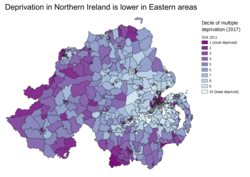Multiple deprivation index

Imagine you have a bunch of friends, and some of them have more toys, food and fun things to do than others. But some friends don't just have less toys, they also have a harder time getting food, going to school, and staying healthy.
Now imagine we wanted to study how different neighborhoods in a city are doing when it comes to things like education, income, health, and safety. Researchers might use a Multiple Deprivation Index to measure this.
The Multiple Deprivation Index is like a list of things that researchers use to see how hard or easy it is to live in different neighborhoods. So they might look at things like how many people in a neighborhood are unemployed, how many people are living in crowded housing that is not very safe, how many people have a hard time getting to a doctor or hospital.
When researchers have gathered information about all these different things in each neighborhood, they can add up all the scores to make one big score for the neighborhood. The bigger the score, the more deprived the area is.
By using this index, researchers can learn about which neighborhoods are the most deprived, and try to figure out why that is. They can use what they learn to make plans to help people in those neighborhoods get the things they need to live a happy and healthy life, just like your friends who have lots of toys and fun things to do.
Now imagine we wanted to study how different neighborhoods in a city are doing when it comes to things like education, income, health, and safety. Researchers might use a Multiple Deprivation Index to measure this.
The Multiple Deprivation Index is like a list of things that researchers use to see how hard or easy it is to live in different neighborhoods. So they might look at things like how many people in a neighborhood are unemployed, how many people are living in crowded housing that is not very safe, how many people have a hard time getting to a doctor or hospital.
When researchers have gathered information about all these different things in each neighborhood, they can add up all the scores to make one big score for the neighborhood. The bigger the score, the more deprived the area is.
By using this index, researchers can learn about which neighborhoods are the most deprived, and try to figure out why that is. They can use what they learn to make plans to help people in those neighborhoods get the things they need to live a happy and healthy life, just like your friends who have lots of toys and fun things to do.
